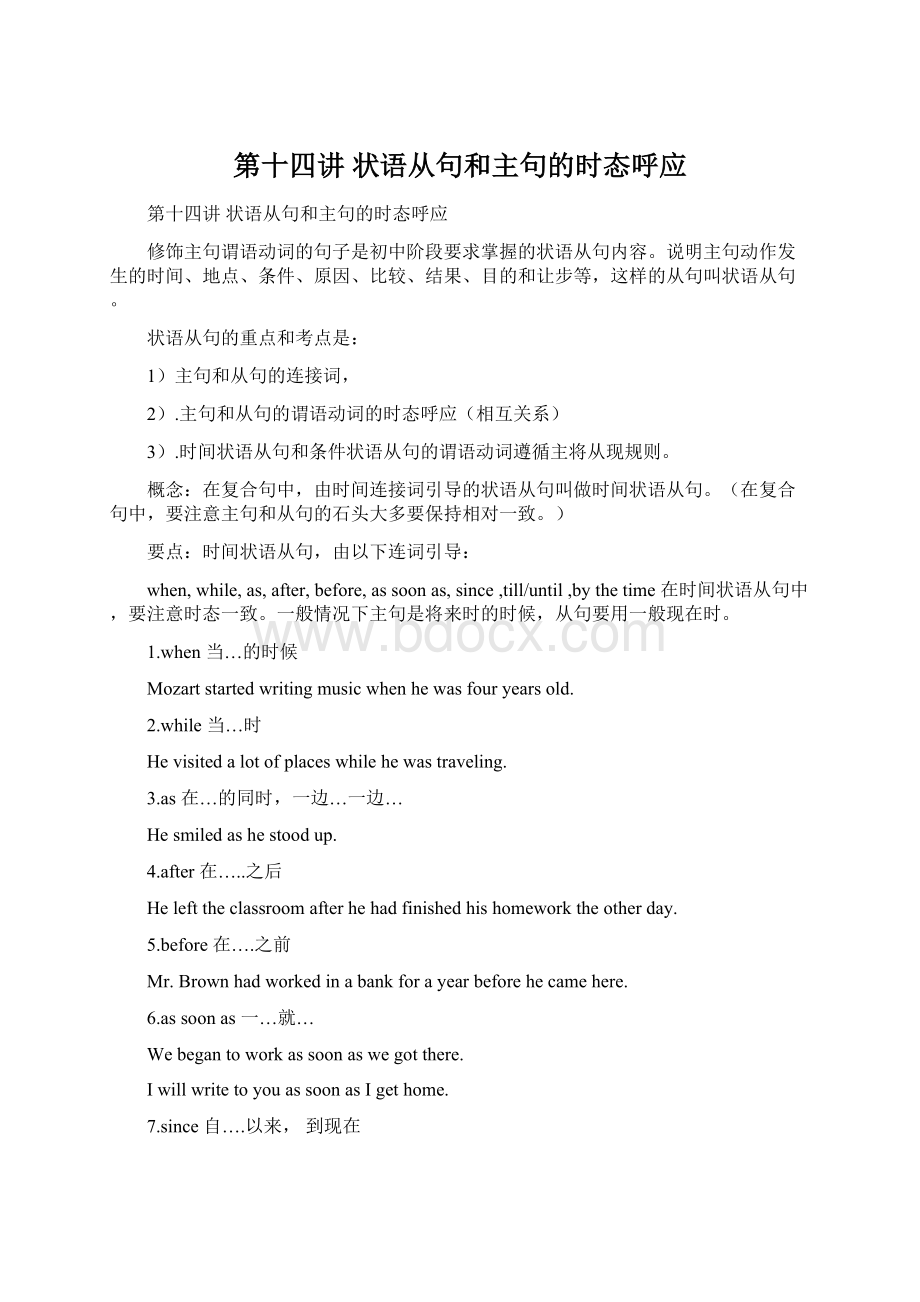 第十四讲 状语从句和主句的时态呼应Word文档格式.docx
第十四讲 状语从句和主句的时态呼应Word文档格式.docx
- 文档编号:21586183
- 上传时间:2023-01-31
- 格式:DOCX
- 页数:21
- 大小:29.53KB
第十四讲 状语从句和主句的时态呼应Word文档格式.docx
《第十四讲 状语从句和主句的时态呼应Word文档格式.docx》由会员分享,可在线阅读,更多相关《第十四讲 状语从句和主句的时态呼应Word文档格式.docx(21页珍藏版)》请在冰豆网上搜索。

5.before在….之前
Mr.Brownhadworkedinabankforayearbeforehecamehere.
6.assoonas一…就…
Webegantoworkassoonaswegotthere.
IwillwritetoyouassoonasIgethome.
7.since自….以来,到现在
表示自过去的一个时间起点到目前(说话时间)为止的一段持续时间,主句一般用现在完成时,从句用一般过去时。
MrGreenhastaughtinthatschoolsincehecametoChinathreeyearsago.
(还可以作介词,本句从句还可以用短语:
sincethreeyearsago)
8.till/until
都可以作连词,连接时间状语,也可以作介词,与其他词构成介词短语,在句中作状语
Theywalkedtill/untilitwasdark.
XiaoMingdidn’tleavehometill/untilhisfathercameback.
9.bythetime到…为止(所在句子的主句应用完成时)
Bythetimehegetsthere,hisfatherhasalreadygone.
BythetimeIgottoschool,theclasshadalreadybegan.
一、时间状语从句(adverbialclauseoftime)
1.由when,while,as引导的时间状语从句
Whenyouthinkyouknownothing,thenyoubegintoknowsomething.
Whentruthisburiedunderthegrounditgrows,itchokes,itgatherssuchanexplosiveforcethatonthedayitburstsout,itblowsupeverythingwithit.
Strikewhiletheironishoe.
WillyouwatchmyclotheswhileIhaveaswim.
Youcanfeeltheairmovingasyourhandpushesthroughit.
Ourheadmasterlaughedasshespoke.
when,while和as的区别
when引导的从句的谓语动词可以是延续性的动词,又可以是瞬间动词,并且,when有时间,表示“就在那时”,如:
Whenshecamein,Istoppedeating.
WhenIlivedinthecountryside,Iusedtocarrysomewaterforhim.
Wewereabouttoleavewhenhecamein.
while引导的从句的谓语动词必须是延续性动词,并强调主句和从句的动作同时发生。
(或者相对应)。
while有时还表示对比。
Whilemywifewasreadingthenewspaper,IwaswatchingTV.(wasreading是延续性动词。
reading和waswatching同时发生。
Ilikeplayingfootballwhileyoulikeplayingbasketball.
As表示“一边…一边”,as引导的动作是延续性的动作一般用用于主句和从句动作同时发生。
as也可以强调“一先一后”。
如:
Wealwayssingaswewalk.
Aswewasgoingout,itbegantosnow.
(as强调句中两个动作紧接着先后发生,而不强调开始下雪的特定时间。
表示“一边…一边”的意思
as强调两个动作同时进行,并表示对比时用于发生时间较短时。
when
1).还可以表示从句动词的动作在主句动词的动作“之前”或“之后”发生。
2).when=andthen,,atthatmoment
while
1).用于时间较长者。
2).强调两个动作同时进行,并表示对比时。
有时这三个词可以互换,有时不可以。
Itwasraininghardwhen(as)Igotthere.(从句的动作发生在主句之前,只能用when)
Hewasabouttoleave,whenthetelephonerang.
while,as不能代替
ShethoughtIwastalkingaboutherdaughter,while,infact,Iwastalkingaboutmydaughter.(表示转折,对比,when,as都不能代替)
Whilethealienwasbuyingasouvenir,thegirlcalledthepolice.(同时进行)
MotherwasworriedbecauselittleAlicewasill,especiallyas(when/while)fatherwasaway.
2.由before和after引导的时间状语从句。
注意before引导的从句不再用否定式的谓语,并且当before引导的从句位于主句之后,有时译成“就,才”,还有注意主句和从句之间的时间关系。
当主句用将来时,从句总是yoga现在时。
如果before引导的从句谓语用的是过去时,则主句动词多用于过去完成时,这样以便体现动作发生的先后。
after表示主句动作发生在从句动作之后。
主句和从句的动作的时间关系正好与before引导的从句相反。
Itwillbefourdaysbeforetheycomeback.
Einsteinalmostknockedmedownbeforehesawme.
Theyhadnotbeenmarriedfourmonthsbeforetheyweredivorced.
Afteryouthinkitover,pleaseletmeknowwhatyoudecide.
Afterwehadfinishedthework,wewenthome.
3.由till或until引导的时间状语从句
till和until一般情况下两者可以互换,单数在强调句型中多用until,并且要注意的是:
如果主句中的谓语动词是瞬间动词时,必须用否定形式;
如果主句中的谓语动词是延续性动词时,用肯定或否定形式都可以,但表达的意思不同。
Ididn’tgotobeduntil(till)myfathercameback.
ItwasnotuntilthemeetingwasoverthathebegantoteachmeEnglish.
Iworkeduntilhecameback.
Ididn’tworkuntilhecameback.
PleasewaituntilIarrived.
4.由since引导的时间状语从句
since引导的时间状语从句谓语动词可以是延续性的动词,又可以是瞬间动词,一般情况下,从句谓语动词用一般过去时,而主句的谓语动词用现在完成时。
但在Itis+时间+since从句的句型中,主句多用一般现在时。
IhavebeeninBeijingsinceyouleft.
WherehaveyoubeensinceIlastsawyou
ItisfouryearssincemysisterlivedinBeijing.
ItisfivemonthssinceourbosswasinBeijing.
知识拓展
Itissince从……以来多长时间了(since+从句或名词,表示一段时间)
Itisfiveyearssincewemetlasttime.
2.itis+before…(…才.)
ItwasalongtimebeforeIwenttosleepagain.
Itwasanhourbefore(=until)thepolicearrived
5.assoonas,immediately,directly,instantly,themoment,theinstant,theminute,等引导的时间状语从句,这些连词都表示“…就.”。
IwillgotheredirectlyIhavefinishedmybreakfast.
ThemomentIheardthenews,Ihastenedtothespot6/
AssoonasIreachCanada,Iwillringyouup.
注意:
hardly(scarecely,rarely)…when/before,nosooner…than相当于assoonas之意。
主句用过去完成时,从句用一般过去时。
当hardly,scarcely,rarely和nosooner位于句首时,主句应用倒装句。
Hehadnosoonerarrivedhomethanhewasaskedtostartonanotherjourney.
Nosoonerhadthesunshownitselfabovethehorizonthanhegotoutofbedtocommencework.
HardlyhadIsatdownwhenhesteppedin.
Hehadhardlyfallenasleepwhenhefeltasofttouchonhisshoulder.
6.由bythetime引导的时间状语从句。
注意时态的变化:
在一般情况下,如果从句的谓语动词用一般过去时,主句的谓语动词用过去完成时;
如果主句的谓语动词用一般现在时,主句的谓语动词用将来完成时。
Bythetimeyoucameback,Ihadfinishedthisbook.
Bythetimeyoucomeheretomorrow,Iwillhavefinishedthiswork.
7.由eachtime,everytime和whenever引导的时间状语从句。
EachtimehecametoHarbin,hewouldcallonme.
Wheneverthatmansays“Totellthetruth”,Isuspectthathe’sabouttotellalie.
YougrowyoungereverytimeIseeyou.
8.由aslongas和solongas引导的时间状语从句。
这两个连词表示“有多久…就多久”,通常翻译为“只要”。
Youcangowhereyoulikeaslongasyougetbackbeforedadrk.
Iwillfightagainsttheseconditionsaslongasthereisabreathinmybody!
二、地点状语从句(adverbialclauseofplace)
地点状语从句一般由连接副词where,wherever等引导,已经形成了固定的句型。
由连词where和复合关系词wherever(=农matterwhere)引导。
句型1.where+地点从句,(there)+从句。
此句型通常翻译成“哪里…….哪里就….”,主句在从句后面时,there可用可不用,如果主句在从句的前面时,一般都不用there。
Wherethereisnorain,farmingisdifficultorimpossible.
Theyweregoodpersons.Wheretheywent,theretheywerewarmlywelcomed.
Youshouldhaveputthebookwhereyoufoundit.
WheretheCommunistPartyofChinagoes,thereithepeopleareliverated.
句型2.Anywhere/wherever+地点从句,+主句
anywhere本身是个副词,但是,常可用引导从句,相当于连词,意思相似于wherever.,anywhere引导的从句可位于主句之前,也可以位于主句之后。
而wherever本身就是个连词,表示“在何处,无论何处”,如:
Wheretheseasi,youwillfindseamen.
Wherethereisawill,thereisaway.
Itwillbemixedschoolwherenotallthechildrenaredisabled.
3.whereveryougo,Igotoo.
Whereverthereissomke,thereisfire.
Whileshewaswonderingwheretogo,shemetapoliceman.
疑问副词where后跟不定式,构成不定式短语。
三,条件状语从句
条件状语从句由连词if,unless(=ifnot)引导。
Ifitdoesn’traintomorrow,wewillgohiking.
Youwillgetgoodgradesifyoustudyhard.
Youwillbelateunlessyouleaveimmediately.
难点提示:
用条件状语从句时要注意时态的正确使用,当主句是将来时的时候,从句要用一般现在时。
Hewillnotleaveifitisn’tfinetomorrow.
Theyaregoingtohaveapicnicifitdoesn’trainnextweek.
四。
原因状语从句
有连词because,since,as引导,也可由for,nowthat等词引导
1.Ididn’tgotoschoolyesterdaybecauseIwasill.
2.Sinceeverybodyishere,let’sbeginourmeeting.
3.Asyouareinpoorhealth,youshouldnotstayuplate.
4.Iaskedhertostaytotea,forIhadsomethingtotellher.
难点:
because,since,as,for辨析。
1).because语势最强,用来说明人所不知的原因,回答why提出的问题,当原因是显而易见的已为人们所知,就用as或since.
Ididn’tgo,becauseIwasafraid.
Since/Astheweatherissobad,wehavetodelayourjourney.
2).由because引导的从句如果放在句末,且前面有逗号,则可以用for来代替,但如果不是说明直接原因,二十多种情况加以推测,就只能用for.
Heisabsenttoday,forheisill.
Hemustbeill,forheisabsenttoday.
3).as和for的区别
通常情况下,as引导的从句在主句前,for引导的从句在主句后,如:
Astheweatheriscold,Istayathome.=Istayathome,fortheweatheriscold.
五。
目的状语从句
目的状语从句由连词that,sothat,so…that,inorderthat引导、
1.sothat以至,以便
I’llrunslowlysothatyoucancatchupwithme.
Iopenedthewindowsothatfreshairmightcomein.
2.inorderthat=sothat为了
Weshallletyouknowthedetailssooninorderthatyoucan/maymakeyourarrangements.
3.despite不是连词,不能引导句子。
六、结果状语从句
结果状语从句由连词(so)that,so…that,such…that,somuch/many….that引导。
1.so…that如此…以至于
Thescientist’sreportwassoinstructivethatwewereallveryexcited.
Healwaysstudiedsohardthathemadegreatprogress.
2.such…that如此,以至于
It’ssuchniceweatherthatallofuswanttogotothepark.
3.比较:
so和such
其规律由so与such的不同词性决定。
such是形容词,修饰名词或名词词组,so是副词,只能修饰形容词或副词。
so还可与表示数量的形容词many,few,much,little连用,形成固定搭配。
sofoolish,suchafool
soniceaflower,suchaniceflower
somany/fewflowers,suchniceflowers
somuch/littlemoney,suchrapidprogress
somanypeople,suchalotofpeople
(somany已成固定搭配,,alotof虽然相当于many,但alotof为名词性的,只能用such搭配,)
so…that与such…that之间的转换即为so与such之间的转换。
难点
+形容词或副词
+形+a(an)+单数可数名词+that
+much或little+不可数名词
sothat,such…that都可以inorderthat两者都可引导目的状语从句和结果状语从句。
当他们引导目的状语从句时,从句的谓语里常常有can,could,may,might,will,would等词。
so+adj或adv+that,such+n+that以上两者句型都表示结果,其中so为副词,后接形容词,副词原形,当可数名词前有many,few,不可数名词前有much,little修饰时,应采用句型somany(few,much,.lttle)+n。
such为形容词,后只能接名词,这名词既可以是可数的,也可以是不可数的,如果这名词是可数,单数,则必须在名词前加冠词(a/an).
常见的形式是:
sucha(beautiful)garden,such(nice)people.
1.I‘vehadsomanyfallsthatI‘mblackandblueallover..
2.TherearesofewnotebooksthatI’can’tgiveyouany.
3.ItissuchniceweatherthatI’dliketotakeawalk.
4.Mikeissohonestamanthatweallbelievehim.=Mikeissuchanhonestmanthatweallbelievehim
5.TheweatherissonicethatI’dliketotakeawalk.
七、让步状语从句
表示让步的状语从句由连词though,although引导。
though,although当虽然讲,都不能和but连用,Although(though)…but的格式是不对的。
但是他们都可以用yet(still)连用,所以though(although)…yet(still)的格式是正确的。
错:
Althoughheisrichbutheisnothappy.
对:
Althoughheisrich,yetheisnothappy.
Althoughwehavegrownup,ourpa
- 配套讲稿:
如PPT文件的首页显示word图标,表示该PPT已包含配套word讲稿。双击word图标可打开word文档。
- 特殊限制:
部分文档作品中含有的国旗、国徽等图片,仅作为作品整体效果示例展示,禁止商用。设计者仅对作品中独创性部分享有著作权。
- 关 键 词:
- 第十四讲 状语从句和主句的时态呼应 第十四 状语 从句 主句 时态 呼应
 冰豆网所有资源均是用户自行上传分享,仅供网友学习交流,未经上传用户书面授权,请勿作他用。
冰豆网所有资源均是用户自行上传分享,仅供网友学习交流,未经上传用户书面授权,请勿作他用。


 对中国城市家庭的教育投资行为的理论和实证研究.docx
对中国城市家庭的教育投资行为的理论和实证研究.docx
